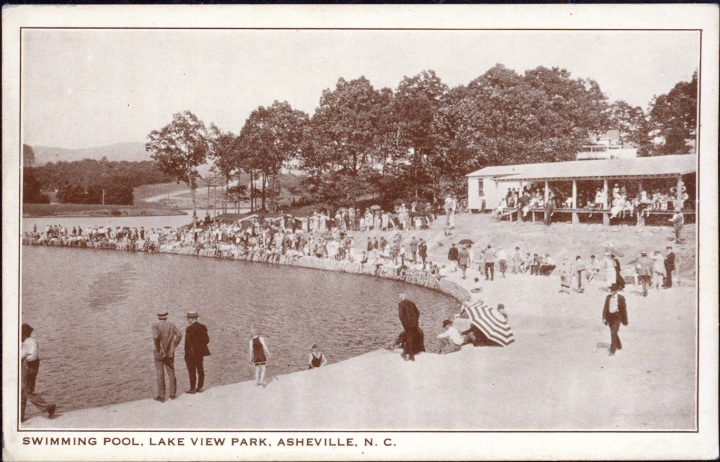On March 31, 1922, The Asheville Citizen reported that “[s]everal weeks ago Lakeview Incorporated came into existence when a number of prominent residents of the city purchased lands in Beaverdam valley and announced their intentions of building a lake and developing a residential section.”
By April, the area, originally designated Lakeview Park, was renamed Beaver Lake. That same month, John Nolen was hired by the committee as the project’s landscape architect. Nolen, an expert city planner from Cambridge, Mass., had first arrived in Asheville that March to help supervise the city’s plans for new, more efficient roadways.
Before construction could begin on the lake, an agreement needed to be reached between Lakeview Inc. and the Asheville and East Tennessee Railroad. The railroad company’s tracks traversed the area Beaver Lake intended to occupy. Ongoing negotiations between the two parties soon soured.
On April 23, 1922, The Sunday Citizen reported that plans for the lake had been abandoned. The article said:
“Mr. [Fred L.] Sale [secretary of Lakeview Inc.] declared that there was a general regret from the stockholders that it would be impossible, because of the stand taken by the railroad company, to construct the lake originally contemplated, but that further negotiations would apparently yield no benefit, and therefore the matter is closed as far as the company is concerned.”
However, by January 1923, plans for the lake were back on; the railway had declared bankruptcy. The Jan. 14 edition of The Sunday Citizen reported that “during the past year, with the improvement of the highway, bus lines have made operation of the railroad a financial failure.”
Two weeks later, on Jan. 29, 1923, The Asheville Citizen wrote:
“Beaver Lake, covering 72 acres, situated on the Dixie Highway, within a short distance from the city, well stocked with game fish, bordering on a sand bank and furnishing recreation for thousands of visitors to Asheville, filling what has been pronounced as one of the outstanding needs for this section, begins to loom as a reality, with workmen busy clearing away underbrush and debris from the lake site in Beaverdam Valley.”

Original plans projected the lake’s completion that summer. But delays ensued. More than a year later, the March 12, 1924, edition of The Asheville Citizen provided further details about the project’s scope, noting “a concrete swimming and wading pool just off the main highway leading through the property.”
By early summer, anticipation for the lake’s opening grew. On June 22, The Sunday Citizen wrote:
“Beaver Lake has proved itself an unusual attraction during the hot weather of the past week. Every evening there have been hundreds of cars parked along the Dixie Highway and on the wide approach to the dam and new concrete bridge which is being constructed across Beaver Creek, to connect up the new drive around the lake, enjoying the moonlight on the water and the cool breezes and the wonderful scenic effort.”
The article noted the completed swimming pool, along with its diving boards. But the development of the area’s sand beach was still underway. The paper went on to imagine the future “bathing beauties” who would bask “under the large beach sun shades or in the beach chairs that will provide for those who do not care to lie in the sand.”
Finally, on July 16, 1924, an advertisement in The Asheville Citizen announced Beaver Lake’s official opening, set for the following day, Thursday, July 17. Swimming races would be held. Diving contests and canoe races would take place, as well.
Two days later, on July 18, The Asheville Citizen recapped the opening day’s events. The paper wrote:
“The beaches of Florida appeared transplanted to the Land of the Sky for a little while yesterday afternoon, when the opening of the Persian Pool at Beaver Lake with acquatic sports was witnessed by almost 2000 people. The green hillsides were almost hidden under the rows of automobiles which taxed even the spacious parking places of Lake View.”
The article continued with descriptions of the “colorful crowds, scattered about under gay umbrellas.” Later on, it noted “[t]he large lake beyond the pool … dotted by canoes, rowboats, motorboats and swimmers, enjoying themsleves in the largest stretch of water that has been available in the immediate vicinity of Asheville.”
The swimming pool at Beaver Lake would remain open until 1952. That year, the Lake View Park Commission proposed the pool be leased to the city of Asheville. But City Council would ultimately reject the proposal, in part, due to cracks discovered in the wall dividing the swimming pool and the lake. By January 1953, Lake View property owners voted in favor of dismantling the Beaver Lake pool, leading to the destruction of its dilapidated wall.
Editor’s note: Peculiarities of spelling and punctuation are preserved from the original documents.





I looked at buying a distressed property in that neighborhood, and part of the sales materials were the original plat map and neighborhood rules for becoming a property owner. I got a quick, explicit education in how southern Asheville really is. To a real Yankee (born in MA, RI, NH, ME, VT or CT) these historical facts are not always readily apparent.